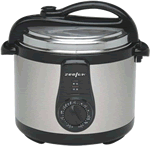|
Pressure Cooker Cooking  The boiling point of water changes with air pressure. As you go higher up a mountain, the boiling temperature decreases because the atmospheric pressure decreases as you climb higher into the atmosphere (less dense air bombarding you). At sea level (standard atmospheric pressure), the boiling point of water is 100 oC (212 oF). As a general rule, the temperature decreases by 1 oF for every 540 feet of altitude (0.56oC for every 165 meters). On top of Pike's Peak, at 14,000 feet, the boiling point of water is 187 oF (86 oC). So food boiled at sea level has a 14oC bigger temperature difference than food boiled on Pike's Peak. The lower temperature difference means a longer cooking time is needed as it is the difference in temperature that determines how fast heat energy is transferred between two objects. The bigger that temperature difference the faster the heat energy is transferred. The food pieces in the boiling water have an outer temperature of that boiling water.their innermost temperature will start off at the temperature at which the food was stored. It takes time for the heat to conduct through the food - and the bigger the temperature difference the faster the conduction process will occur. A typical pressure cooker applies pressure so that the boiling point of water rises to 121 oC (250 oF) at sea level. The higher temperature means that foods take less time to cook as there is a bigger temperature difference between the middle of the food and its surface.
|
Follow me...
|


 Pressure cookers work by the same principle, but a pressure cooker raises the pressure of the air in the cooker so that the water boils at a higher temperature.
Pressure cookers work by the same principle, but a pressure cooker raises the pressure of the air in the cooker so that the water boils at a higher temperature. 


